Mengchao He
Conditional Text Image Generation with Diffusion Models
Jun 19, 2023Abstract:Current text recognition systems, including those for handwritten scripts and scene text, have relied heavily on image synthesis and augmentation, since it is difficult to realize real-world complexity and diversity through collecting and annotating enough real text images. In this paper, we explore the problem of text image generation, by taking advantage of the powerful abilities of Diffusion Models in generating photo-realistic and diverse image samples with given conditions, and propose a method called Conditional Text Image Generation with Diffusion Models (CTIG-DM for short). To conform to the characteristics of text images, we devise three conditions: image condition, text condition, and style condition, which can be used to control the attributes, contents, and styles of the samples in the image generation process. Specifically, four text image generation modes, namely: (1) synthesis mode, (2) augmentation mode, (3) recovery mode, and (4) imitation mode, can be derived by combining and configuring these three conditions. Extensive experiments on both handwritten and scene text demonstrate that the proposed CTIG-DM is able to produce image samples that simulate real-world complexity and diversity, and thus can boost the performance of existing text recognizers. Besides, CTIG-DM shows its appealing potential in domain adaptation and generating images containing Out-Of-Vocabulary (OOV) words.
AGTGAN: Unpaired Image Translation for Photographic Ancient Character Generation
Mar 13, 2023



Abstract:The study of ancient writings has great value for archaeology and philology. Essential forms of material are photographic characters, but manual photographic character recognition is extremely time-consuming and expertise-dependent. Automatic classification is therefore greatly desired. However, the current performance is limited due to the lack of annotated data. Data generation is an inexpensive but useful solution for data scarcity. Nevertheless, the diverse glyph shapes and complex background textures of photographic ancient characters make the generation task difficult, leading to the unsatisfactory results of existing methods. In this paper, we propose an unsupervised generative adversarial network called AGTGAN. By the explicit global and local glyph shape style modeling followed by the stroke-aware texture transfer, as well as an associate adversarial learning mechanism, our method can generate characters with diverse glyphs and realistic textures. We evaluate our approach on the photographic ancient character datasets, e.g., OBC306 and CSDD. Our method outperforms the state-of-the-art approaches in various metrics and performs much better in terms of the diversity and authenticity of generated samples. With our generated images, experiments on the largest photographic oracle bone character dataset show that our method can achieve a significant increase in classification accuracy, up to 16.34%.
Context-Aware Selective Label Smoothing for Calibrating Sequence Recognition Model
Mar 13, 2023Abstract:Despite the success of deep neural network (DNN) on sequential data (i.e., scene text and speech) recognition, it suffers from the over-confidence problem mainly due to overfitting in training with the cross-entropy loss, which may make the decision-making less reliable. Confidence calibration has been recently proposed as one effective solution to this problem. Nevertheless, the majority of existing confidence calibration methods aims at non-sequential data, which is limited if directly applied to sequential data since the intrinsic contextual dependency in sequences or the class-specific statistical prior is seldom exploited. To the end, we propose a Context-Aware Selective Label Smoothing (CASLS) method for calibrating sequential data. The proposed CASLS fully leverages the contextual dependency in sequences to construct confusion matrices of contextual prediction statistics over different classes. Class-specific error rates are then used to adjust the weights of smoothing strength in order to achieve adaptive calibration. Experimental results on sequence recognition tasks, including scene text recognition and speech recognition, demonstrate that our method can achieve the state-of-the-art performance.
Implicit Feature Alignment: Learn to Convert Text Recognizer to Text Spotter
Jun 10, 2021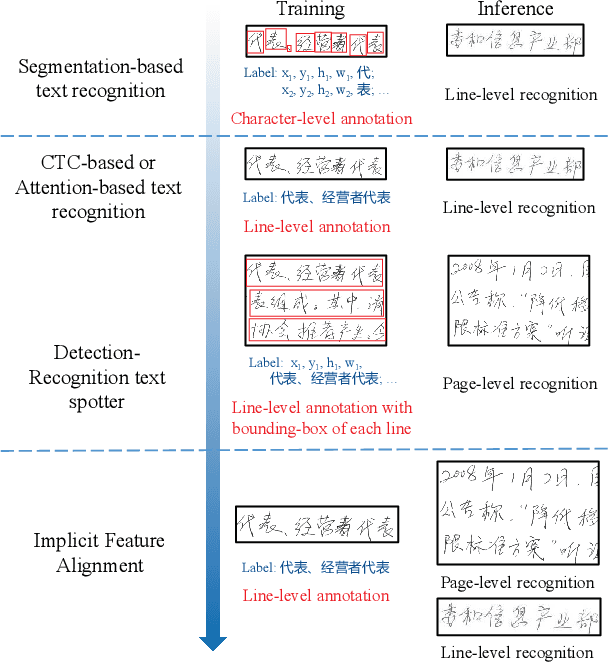

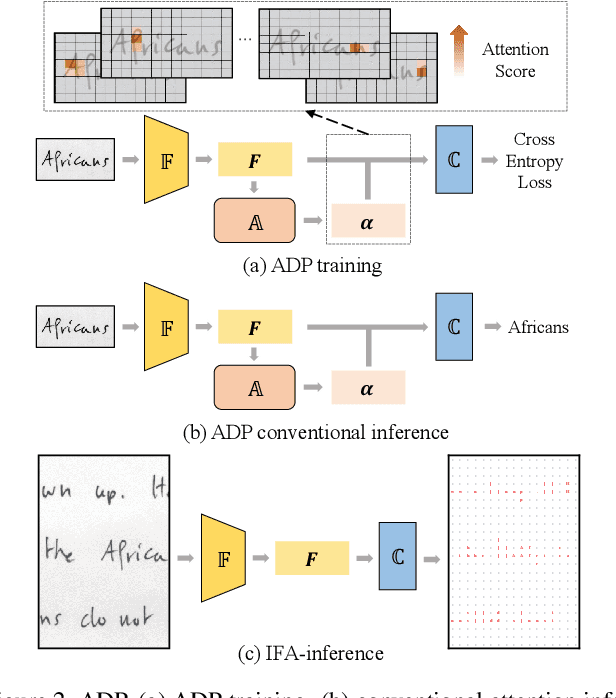
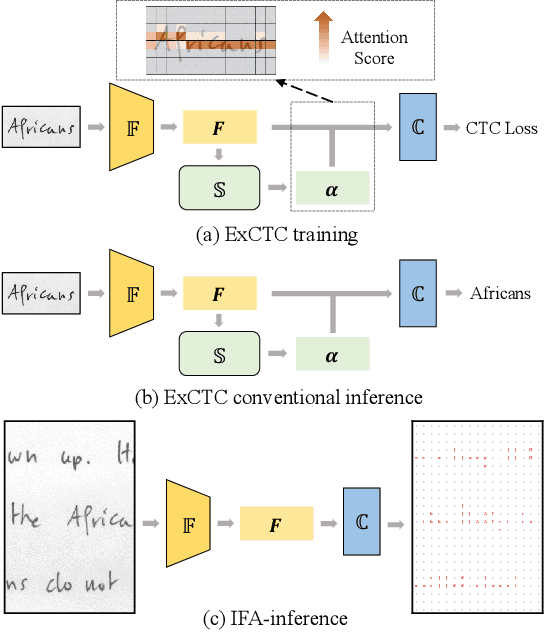
Abstract:Text recognition is a popular research subject with many associated challenges. Despite the considerable progress made in recent years, the text recognition task itself is still constrained to solve the problem of reading cropped line text images and serves as a subtask of optical character recognition (OCR) systems. As a result, the final text recognition result is limited by the performance of the text detector. In this paper, we propose a simple, elegant and effective paradigm called Implicit Feature Alignment (IFA), which can be easily integrated into current text recognizers, resulting in a novel inference mechanism called IFAinference. This enables an ordinary text recognizer to process multi-line text such that text detection can be completely freed. Specifically, we integrate IFA into the two most prevailing text recognition streams (attention-based and CTC-based) and propose attention-guided dense prediction (ADP) and Extended CTC (ExCTC). Furthermore, the Wasserstein-based Hollow Aggregation Cross-Entropy (WH-ACE) is proposed to suppress negative predictions to assist in training ADP and ExCTC. We experimentally demonstrate that IFA achieves state-of-the-art performance on end-to-end document recognition tasks while maintaining the fastest speed, and ADP and ExCTC complement each other on the perspective of different application scenarios. Code will be available at https://github.com/WangTianwei/Implicit-feature-alignment.
All You Need Is Boundary: Toward Arbitrary-Shaped Text Spotting
Nov 21, 2019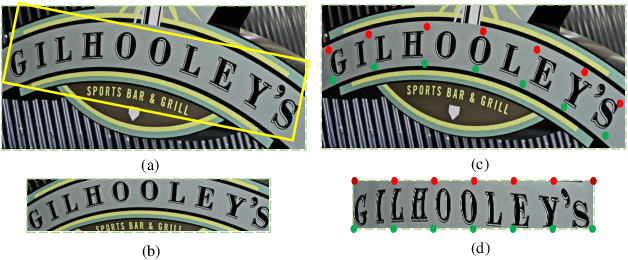
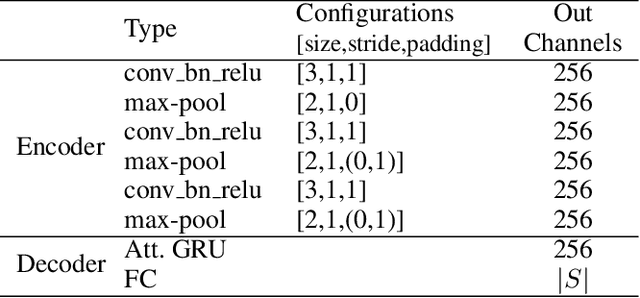
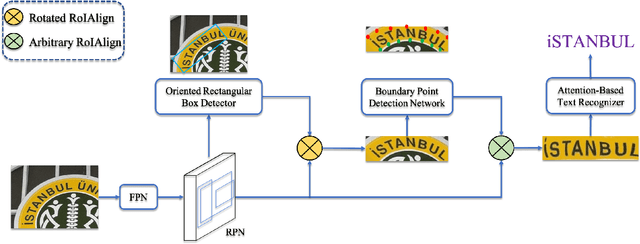

Abstract:Recently, end-to-end text spotting that aims to detect and recognize text from cluttered images simultaneously has received particularly growing interest in computer vision. Different from the existing approaches that formulate text detection as bounding box extraction or instance segmentation, we localize a set of points on the boundary of each text instance. With the representation of such boundary points, we establish a simple yet effective scheme for end-to-end text spotting, which can read the text of arbitrary shapes. Experiments on three challenging datasets, including ICDAR2015, TotalText and COCO-Text demonstrate that the proposed method consistently surpasses the state-of-the-art in both scene text detection and end-to-end text recognition tasks.
 Add to Chrome
Add to Chrome Add to Firefox
Add to Firefox Add to Edge
Add to Edge